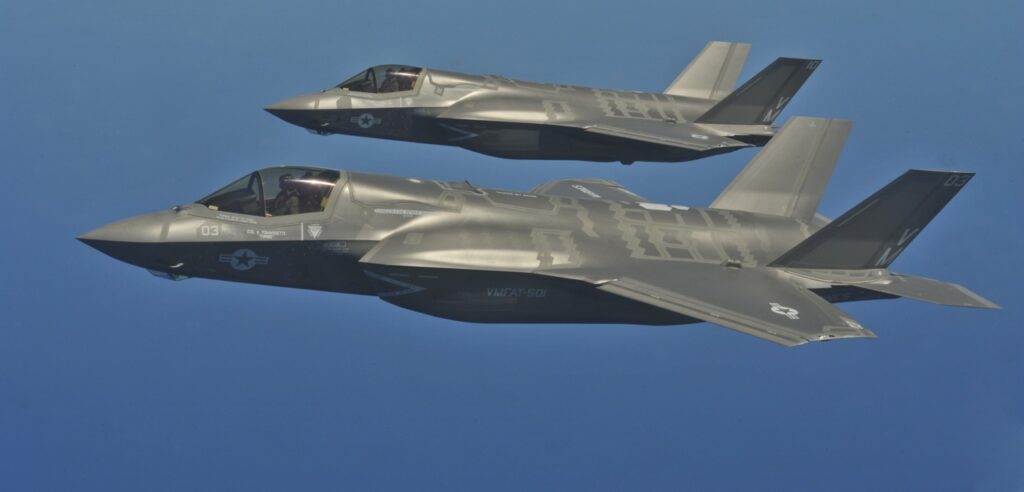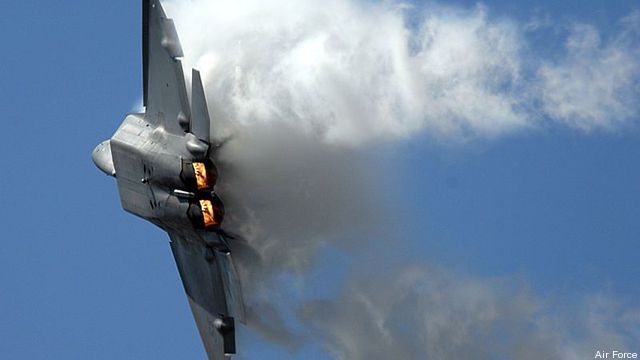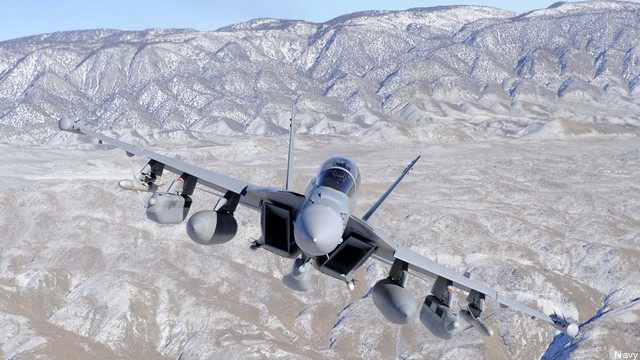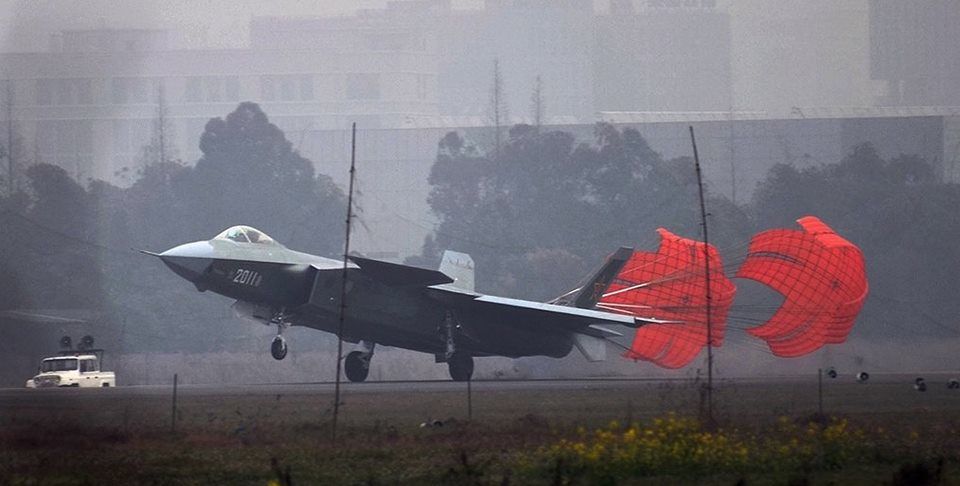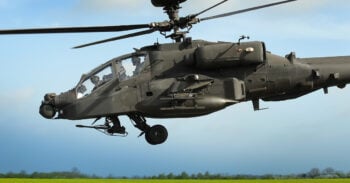For years, the news about the most expensive conventional weapons system in US history, the F-35 Joint Strike Fighter, has been driven by its soaring costs, technical problems and schedule screw-ups. The government and Congress and the public rarely speak about what the F-35 will do, how effectively it could destroy an enemy’s air defenses, shoot down an enemy plane, or find and strike other high value targets.
As the first variant to be ready for combat, the Marine Corps F-35B, approaches what is known as its Initial Operating Capability and prepares to make its first flights outside the United States in the UK this July, Air Force Gen. Mike Hostage, who will command the largest group of F-35s in the world, sat down in his office at Langley Air Force Base to discuss what the F-35 can do in the first 10 days of war — within the constraints of what is classified — and in the case of this weapon, much of what it does remains highly classified.
I spoke with dozens of experts in the government, the defense industry and academia about likely scenarios for the F-35 and to flesh out some of its capabilities. This is the main piece we’re running this week about the F-35, based on my interview with Gen. Hostage and those other experts. The second piece deals with the cyber and electronic warfare capabilities of the F-35.
The issue of how effective the F-35 would be in a classic dogfight often arises. Gen. Hostage noted during our interview that the F-35 pilot who engages in a dogfight has either made a mistake or been very unlucky. Shooting down other planes using kinetics is only one role of the F-35. Perhaps air forces around the world are going to have to come up with a new honor other than ace to define those who fly the F-35. What should a pilot be awarded for outsmarting the best air defense systems in the world or injecting something like Stuxnet into the enemy’s command and control system? So much of what this aircraft will do has nothing to do with shooting down another pilot that we may need a new term.
LANGLEY AFB: After months of name-calling and increasingly aggressive sea and air patrols around the Senkaku and Spratly islands, a Chinese frigate rams and sinks a Japanese Aegis ship patrolling near Uotsuri Jima on Christmas Eve 2021. Is it accidental? Irrelevant. After repeated provocations and increasingly shrill pronouncements by Chinese leaders, the Japanese people have had enough. Japan scrambles fighters and bombers to protect the Senkaku Islands, Okinawa, and the rest of its southern and western flanks. In response, China’s most capable aircraft carrier deploys fighters from just outside Japanese territorial waters.
After decades of sporadic but increasingly violent confrontations, these actions finally prompt Japan to invoke its mutual defense treaty with the United States. As several hundred Chinese J-20s are scrambled and streak toward the Japanese islands, more than 500 F-35s from the US, Korea and Japan join 70 F-22s roaring off flight lines from across the Pacific. US Air Force F-35As take off from hardened air bases in Japan and a now-unified Korea. Roughly half the F-35B fleet in the region zoom off from ships and locations scattered across the Pacific where they have been moved far from hardened facilities as tensions rose. A small force of F-35Cs join Growlers and F/A-18 Super Hornets fly picket for the three US carrier groups operating in the region. The bulk of the F-35C force sits ready on the three flight decks, ready as a reserve force, along with the half of the allied force’s F-35Bs poised on highways and ships scattered across the Pacific theater.
China’s most advanced integrated air defense systems — largely upgraded systems based on Russian S-400 models — are manned and ready. The J-20s and IADS use both radar and Infrared Search and Track (IRST) sensors for targeting and tracking. This is not just a more advanced version of the air war against Saddam Hussein’s Iraq or the one in the Balkans against Soviet-trained forces in the mid-1990s, when an F-117 stealth fighter was shot down by Serb forces after weeks of the aircraft flying the same air corridor.
The Chinese radar will change their frequencies to monitor and target the allied squadrons. Networked radar systems across China will turn on and off randomly, sharing data with each other and triangulating it for targeting. Combine that networked data with information from the IRST sensors and the tasks of the F-22 and F-35 pilots will grow geometrically more complex.
The best estimates by most experts are that the F-22s will fare quite well in this classic Anti-Access/Area Denial (A2/AD) environment, relying on their unique combination of low observability, super cruise and vectored thrust to strike other aircraft and IADS. But how will the Joint Strike Fighters — about which we know so much about their cost and schedule — fare in war during the crucial period from Day 0 to Day 10?
At least one senior allied official I’ve spoken with believes the F-35 will be “undefeatable” through the 2020s. That’s awfully vague, if impressive. Most of what the public knows is that the F-35 possesses advanced sensors and is stealthy, but that doesn’t answer the fundamental questions either.
First, let’s tackle the standard arguments offered by F-35 critics, especially Growler-builder Boeing and its surrogates. The Growler, officially designated as the E/A-18G, is an advanced electronic warfare version of the F/A-18E/F Super Hornet. Boeing, some Navy experts, and others point to the F-117 shoot-down over Serbia and to the F-35’s “targeted” electronic warfare capabilities and argue that the Growler’s broadband, high-powered jamming make it a natural partner for the “vulnerable” JSF as it goes to war.
The F-35’s jamming isn’t powerful enough and only works as one is flying forward, they say, while the Growler can blanket an enemy’s systems and the back-seater can adjust the Growler’s jamming with more finesse. For example, if an enemy radar is changing frequencies, the Growler can react faster and more effectively because the weapons officer in the back seat can adjust the electronic warfare response. Boeing and other Growler advocates say the F-35’s reliance on a data “library” to make recommendations to the pilot leave it less responsive.
Hostage labels as “old think” those critics who point to the F-117 shoot-down and the presumed supremacy of high-powered electronic-magnetic warfare. “We have one F-117 shot down in 78 days of flying over that country, thousands of sorties. They shot down one airplane,” Hostage says. “And they shot down one airplane because we flew across the same spot on the ground for weeks at a time. It took them multiple weeks to figure out how to shoot the thing. Then they had to get four or five systems to do it. It took them weeks to take it out. I can accept that kind of attrition rate. I obviously don’t want to lose anyone, but good Lord, one airplane over the course of 78 days, that’s pretty impressive.”
Growlers are not front-line aircraft for the first week of war, Hostage argues. They will be useful against a high-end opponent for the same reason that other fourth-generation aircraft such as F-15s and F-16s will be: for “volume” in the face of superior enemy numbers.
However, one Pentagon source familiar with the cyber and electronic warfare capabilities of the F-35, EA-6B and the Growler was more sympathetic to the other planes’ EW capabilities.
“The F-35 complements the EA-6B and EA-18G — not replaces. That may change in some long range plans but in the near future they complement each other,” the source said in an email. “Right now we need them both.” And so the discussion goes. But Gen. Hostage was crystal clear in his assessment.
Stealth Is Not Invisibility
“But in the first moments of a conflict I’m not sending Growlers or F-16s or F-15Es anywhere close to that environment, so now I’m going to have to put my fifth gen in there and that’s where that radar cross-section and the exchange of the kill chain is so critical. You’re not going to get a Growler close up to help in the first hours and days of the conflict, so I’m going to be relying on that stealth to open the door,” Hostage says.
But stealth is not invisibility, especially for fighters that must have tails for maneuverability (rather than the B-2 stealth bomber’s tailless “flying wing” design). Both F-22s and F-35s will be spotted at range by low frequency radar. The F-35’s cross section is much smaller than the F-22’s, but that does not mean, Hostage concedes, that the F-35 is necessarily superior to the F-22 when we go to war. In fact, Hostage says that it takes eight F-35s to do what two F-22s can handle.
“The F-35 is geared to go out and take down the surface targets,” says Hostage, leaning forward. “The F-35 doesn’t have the altitude, doesn’t have the speed [of the F-22], but it can beat the F-22 in stealth.” But stealth — the ability to elude or greatly complicate an enemy’s ability to find and destroy an aircraft using a combination of design, tactics and technology — is not a magic pill, Hostage reminds us.
F-35 First Designed To Kill Advanced Surface to Air Systems
Bear in mind that the F-35 is the first US aircraft designed to the requirement that it be highly effective at neutralizing S-400 systems and their cousins.
“The F-35 was fundamentally designed to go do that sort of thing [take out advanced IADS]. The problem is, with the lack of F-22s, I’m going to have to use F-35s in the air superiority role in the early phases as well, which is another reason why I need all 1,763. I’m going to have some F-35s doing air superiority, some doing those early phases of persistent attack, opening the holes, and again, the F-35 is not compelling unless it’s there in numbers,” the general says. “Because it can’t turn and run away, it’s got to have support from other F-35s. So I’m going to need eight F-35s to go after a target that I might only need two Raptors to go after. But the F-35s can be equally or more effective against that site than the Raptor can because of the synergistic effects of the platform.”
The F-35, critics say, can be spotted by low frequency radar (as can almost any aircraft, no matter how stealthy) and isn’t as good at dogfighting as is the F-22. But Hostage says, as do other senior Air Force and Marine officers, that an F-35 pilot who engages in a dogfight has probably made a mistake or has already broken through those IADS lanes and is facing a second wave of enemy aircraft. The F-35, he says, has “at least” the maneuverability and thrust and weight of the F-16. The F-35 is to the F-22 as the F-16 is to the F-15. The latter aircraft are the kings of air to air combat. The F-35 and the F-16 are the mainstay of the air fleet, designed for both air-to-air and air-to-ground attacks.
But the F-35 possesses much superior sensors compared with the F-16 or the F-15. For example, its Distributed Aperture System gives the pilot the ability to see all around the plane (on top, underneath, in front of and behind) with extremely high resolution. When the DAS or some of the other sensors pick up the signature of an enemy plane or weapon, the F-35’s so-called fusion engine advises the pilot about the best weapon to use against the threat.
It does this by collating data from all of the plane’s sensors, from other F-35s and accompanying planes, analyzing them, comparing the data to a “library” of threats and making recommendations to the pilot, usually right on his highly-advanced helmet’s visor. If there are multiple threats then the F-35 identifies the highest value targets and recommends what weapons to use against them and makes recommendations to the pilot about the order in which to deal with each threat.
Add to the sensors’ sensitivities and the fusion engine’s abilities the fact that a squadron of F-35s share data with each other.
“Fusion says here’s what’s out there. You told me, this one right here’s a threat. Here’s what it’s doing right now. Here’s what your wingman (knows): he sees he’s got a missile on the right, so I’m not going to waste a missile because I already see that my wingman’s taking care of it,” Hostage says.
Fusion Of Stealth, Computing Power, Data
In the end, what marks the F-35 as a dominant weapon is its combination of stealth, computing power, built-in targeting and databases, sensors that we hear can reach out more than 1,200 miles in some scenarios, with all of that fed to the pilot in his cockpit with automatically-generated target, weapons and route choices though his helmet.
“And instead of having to fuse three pieces of information and decide if that’s an adversary or not, the airplane is telling him, with an extremely high degree of confidence, what that adversary is and what they’re doing and what all your wingmen are doing,” Hostage explains. “It’s a stunning amount of information.”
But are the planes against which the JSF is likely to go up against — advanced Russian and Chinese fighters, the Su-35 and the J-20 — superior? Some critics argue the US is fielding an aircraft that is not worth the enormous portion of the Defense Department’s budget the F-35 will absorb.
Hostage concedes the plane is more expensive than anyone thought it would be. But the Lockheed Martin person in charge of the program, Lorraine Martin, has promised the F-35 will cost less than any US fourth generation aircraft by 2019. That presumes the number of aircraft remains stable at the planned amounts, of course.
So what advanced aircraft are F-35s likely to face? Russia has found it impossible, so far, to field numbers of fifth-generation fighters. “The Russians can build one-off systems, can build small numbers of really capable stuff, but they have not yet achieved the industrial capacity to produce in huge volumes,” Hostage tells me.
On the other hand, the Chinese are expected to produce large numbers of J-20s over time. While F-35 critics point to the purportedly advanced features of the new Chinese aircraft, noting apparent improvements in stealth, Hostage is skeptical of the plane’s capabilities, so far.
“They’re just now rolling their prototypes out and flying their supposed fifth gen capability. So it looks like — It’s a Raptor [F-22] look-alike. It doesn’t mean it’s got the same internal capabilities. The systems on board, the fusion on board, the stealth — the jury’s out,” he avers. Regardless of what’s inside them, the Chinese can make lots of planes. “I absolutely believe that the Chinese have the capacity to build a high-quality system. I absolutely believe they have the industrial capacity to build lots of them. That’s what worries me. I have no doubt they’ll get, they’re stealing stuff from us as fast as they can, so that will accelerate their technological path, and then their industrial capacity is impressive.”
In our next piece we consider some of the F-35’s more advanced capabilities that the J-20, the J-31 and their cousins may find difficult to match, at least for now.
Kuwait’s new ‘executive protocol’ with Turkey could mean new weapons, training
“As the Kuwaitis work to modernize their military, Ankara eyes the lion’s share of Kuwait’s defense procurements,” analyst Ali Bakir told Breaking Defense. “Turkey is willing to offer a range of its modern, cost-effective and highly capable weapons…”
















